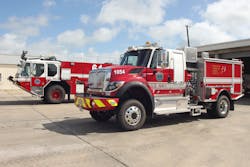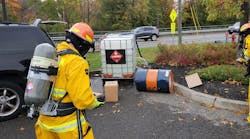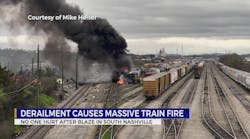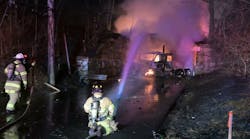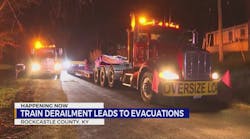Naval Air Station Corpus Christi (NASCC) was established in south Texas in 1941, with a primary mission of aviation training with both initial and advanced pilot training. This mission is carried out by Training Air Wing Four and its four squadrons.
NASCC occupies 5,622 acres (9.78 square miles) with three outlying landing fields and the Corpus Christi Army Depot (CCAD), its largest tenant command. CCAD is located in three geographic locations on the facility with more than 6 million square feet of space and assigned aviation assets. In addition, there are residential neighborhoods on the base where military members and their families live. The total population is approximately 3,400, with peak population during the day exceeding 7,000 personnel. The majority of people working at NASCC are at the CCAD. Also on the base is a U.S. Coast Guard facility with both fixed-wing and helicopter aircraft on site.
CCAD background
CCAD was established in 1961 and is the industry leader for repair and overhaul of helicopter, engines and components in Army aviation. It is the largest rotary wing repair facility in the world.
CCAD has the largest potential fire and hazardous materials risk on the base. This is due to the complex industrial nature of its operations. Even though they are the highest risk, CCAD's operations are conducted in a safe and highly regulated manner. As a result, there is an extremely low incidence of fire and few significant hazardous materials releases. High-severity/low-probability risk is managed through aggressive fire prevention, training and excellent equipment and public education that focuses on each and every CCAD employee. Most incidents are mitigated by the initial response of appropriate resources.
NASCC Fire & Emergency Services
NASCC Fire & Emergency Services (F&ES) was established following commissioning of the facility on March 12, 1941. The first flight training began on May 5, 1941. NASCC F&ES is comprised of 67 personnel, including two civilians, under the leadership of interim Chief Jason Krause (Chief John Morris retired in December 2016). Department tasks are divided into four divisions: Administration, Operations, Fire Prevention and Public Education, and Fire Training, Health, and Safety.
Uniformed personnel operate from five stations on the main installation as well as three at Outlying Landing Fields (OLF), which are located 5.5, 13.6 and 95 miles from the main installation.
Fire and EMS personnel operate two 1,250-gpm engines, a 100-foot platform, a combination hazmat/heavy rescue unit, a BLS medic unit and six ARFF units. Other units include a special operations support trailer, a 1,000-gallon AFFF trailer, and a light and air trailer.
Automatic response has been provided to NASCC by the City of Corpus Christi Fire Department 457 times since 2007, and automatic response has been provided by F&ES to the City of Corpus Christi 355 times since 2007. Beyond actual emergency response, the departments frequently train together, including live-fire (structural and ARFF), technical rescue and hazardous materials training, all to improve interoperability.
NASCC F&ES responded to 1,046 total incidents in 2016, including 11 fires, 235 EMS calls and 239 miscellaneous calls for service.
NASCC F&ES became a Commission on Fire Accreditation International (CFAI)-accredited agency on March 17, 2015. Additionally, NASCC F&ES was selected as the 2014 Department of Defense (DOD) Fire Department of the Year (Medium Category) and as the 2015 Navy Region Southeast Fire Prevention Program of the Year.
Hazmat Team history and apparatus
The DOD initiated a fire and emergency services certification plan in 1994. Following this change in policy, the Hazardous Materials Team at NASCC was formed. NASCC's Hazardous Materials Team and apparatus are located at Station 1 in Corpus Christi.
Special Operations Unit 1061 is a 2011 Pierce Heavy-Duty Rescue Velocity configured as a hazmat/heavy rescue truck. This dual-purpose vehicle carries specialized equipment and supplies for response to hazmat and technical rescue incidents. Support equipment is transported using an 8 x 20-foot Wells Cargo trailer (Support 1081) that carries mass decon tents, over-pack barrels, bulk absorbents, low-pressure airbags and other related equipment. Additional responding units provide staffing and support for the incident itself.
Special Operations 1061 is equipped with a four-bank RSP SpaceSaver Model 100A dual-cylinder, high-pressure, 6,000-psi cascade system. Power and lights to operate the equipment on 1081 is provided by a 25-kW Onan generator and a 9,000-watt (210 total lumens) Night Scan Light Tower. Communications capability includes UHF, VHF and 800-Mhz, which allows interoperability with other units in Nueces County.
NASCC Hazmat personnel
Captain Matthew Sedgwick is the Hazmat coordinator for NASCC F&ES. He also coordinates with other department personnel and outside organizations, including the Corpus Christi Fire Department Hazmat Team (HM12). All firefighters at NASCC are trained to the Hazmat Technician level as required by Navy F&ES. Training is based upon NFPA 472: Standard for Competence of Responders to Hazardous Materials Weapons of Mass Destruction Incidents. Certification is provided through the International Fire Service Accreditation Congress (IFSAC).
Fifty-one hazmat technicians are available to the department, and a minimum of nine are on duty at any given time at Fire Station 1. Selected personnel receive specialized training annually to ensure that knowledge levels and skills are developed for an effective response. Remaining technicians are also available as part of a coordinated response.
Mutual aid is available and provided by Corpus Christi Fire Department Hazmat, which has 54 trained technicians and 18 on duty at any given time. For WMD incidents, the 6th Civil Support Team from the Texas National Guard would be requested for an actual event.
Engine, truck and ARFF vehicles carry a 5-gallon bucket containing dry absorbents, absorbent pillows and absorbent pads.
NASCC Hazmat responded to 39 incidents on base and one mutual aid to Corpus Christi in 2016.
Hazmat PPE
Respiratory protection for hazmat personnel includes Scott Safety Air-Pak 75 CBRNE SCBA with 4,500 psi 60-minute cylinders. In-suit communications is provided by Motorola XTS 5000 portable radios and Savox Talon throat mics and over-ear speakers for use with the Motorola XTS 5000.
Hazmat PPE consists of:
- Kappler Zytron 500 full-encapsulated vapor protective suits (Level A)
- Lakeland Chemmax liquid splash protective suits (Level B)
- Butyl gloves
- Guardian Neoprene gloves
- SilverShield gloves
- Nitrile gloves
- Hazmax boots
Monitoring equipment includes:
- RAE Systems’ MultiRae Plus five-gas detector with 02, LEL, H2S, CO, and PID sensors
- RAE Systems’ MultiRae Lite six-gas detector with 02, LEL, H2S/C0, HCN, and PID sensors
- RAE Systems’ MiniRAE 2000 photoionizing detector (PID) with 10.6eV lamp for detecting volatile organic compounds (VOCs), including poisons and combustibles
- RAE Systems’ MiniRAE 3000 PID with 10.6eV lamp for detecting VOCs, including poisons and combustibles
- Ludlum M2241-2 ERK Radiation Survey Meter
- Canberra ERKADV Radiation Survey Meter
- pH paper for detecting acids and bases
- Fluorine paper for detecting fluorine
- AdVnt Pro Strips 5 kit for detecting anthrax, ricin toxin, botulinum toxin, Yersinia pestis (plague) and Staphylococcus aureus (SEB)
- Ahura FirstDefender, a Raman-based handheld chemical identifier
- Thermo Fisher Scientific TruDefender, a FTIR Handheld Chemical Identifier
Hazmat resources
Computer resources include the U.S. National Library of Medicine's Wireless Information System for Emergency Responders (WISER) online database as well as the U.S. EPA Computer-Aided Management of Emergency Operations (CAMEO). Hard copy reference materials include the DOT Emergency Response Guidebook (ERG), HazMat IQ, the CDC’s NIOSH Pocket Guide to Chemical Hazards, Hawley's Condensed Chemical Dictionary, Sax’s Dangerous Properties of Industrial Materials, Tier II Chemical Report (Texas), and Safety Data Sheets (SDSs, formerly known as Material SDSs). CHEMTREC is also used via phone contact.
Hazmat exposures
Primary hazardous materials at NASCC include, but are not limited to, nitric acid, sodium cyanide, potassium cyanide, sodium hydroxide and chlorine gas. Large quantities of kerosene (JP-8) are used to support over 400,000 annual flight operations. Transportation hazmat exposures are generally limited to the aforementioned chemicals. Deliveries of JP-8 occur on a daily basis to a 600,000-gallon tank farm and are escorted to the fuel farm by Navy law enforcement personnel.
Major incidents
In spite of the potential for a hazmat incident on base, the controlled environment of the facility results in few actual emergencies. This is a primarily the result of prevention efforts coupled with engineered containment systems. F&ES has a strong working relationship with base environmental and industrial hygiene agencies as well as law enforcement, and is instrumental in limiting the impact of incidents.
The most significant incident outside of the controlled areas occurred on April 18, 2013, and involved a transportation vehicle carrying 500 gallons of nitric acid. In addition to being very corrosive, nitric acid is also a strong oxidizer. NASCC Hazmat responded to a report of nitric acid leaking from a truck adjacent to the hazardous waste facility. Initially the tank was leaking slowly, approximately 2-4 gpm from the discharge valve. Leaking nitric acid was being caught in a 60-gallon catch basin by the driver. He was attempting to offload product to available 320-gallon totes. The product discharge valve failed, followed by an uncontrollable loss of product.
An initial evacuation of 150 feet was placed in effect as the acid overflowed containment and reacted with the asphalt causing a visible plume. Asphalt is a petroleum product and reacts with oxidizers to produce a potentially dangerous situation where the fuel and oxidizer, two sides of the fire tetrahedron, are present. Heat from the reaction could be the ignition source and cause a fire.
All of the contents of the tank were released before offensive operations were started. As such, the isolation distance was increased to 500 feet. During the incident, a cold front moved through the area, increasing the wind. Affected facilities sheltered in place.
Mitigation was a combination of adding soda bicarbonate to the spill and bringing in a contractor to clean up the spill. This incident, which halted flight operations, took 3 hours and 18 minutes to stabilize.
